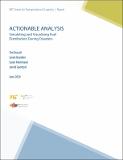Actionable Analysis: Simulating and Visualizing Fuel Distribution During Disasters
Author(s)
Russell, Timothy Edward; Boutilier, Justin James; Kleinmann, Sarah; Goentzel, Jarrod
DownloadFull report (2.916Mb)
Metadata
Show full item recordAbstract
The aim of this project is to develop analytical concepts and tools that can be employed by FEMA to improve supply chain resiliency and adaptability during crises. Proposed frameworks and models are designed for use by emergency management leaders and private sector collaborators to assist in disaster preparedness planning, guide emergency response and recovery, or both. The key is to develop concepts and tools that enable actionable analysis. Fundamental to our research is the concept of sentinel surveillance developed for application in public health and epidemiology. Sentinel surveillance monitors selected nodes in a health network – sentinel points – to collect data that can be used to identify an impending public health issue. Regular data collection at sentinel points can be used to track trends in public health. Sentinel indicators based on such trend data can be tailored to track different public health issues. Further investigation or intervention can be triggered when the sentinel indicator deviates beyond a threshold. We adapt the idea of sentinel surveillance to monitor the health of supply chains, ranging from upstream supply networks to downstream demand networks that serve communities. The focus of
this surveillance is on private sector supply chains that have the most capacity to provide essential commodities. Our analysis aims to identify appropriate sentinel points in private sector networks to diagnose issues, evaluate potential supply chain interventions to accelerate restoration of predisaster business operations, and anticipate where public sector gap-filling support for essential commodities is most needed.
Date issued
2020-07-15Keywords
supply chain managament, humanitarian, disaster, fuel, data visualization